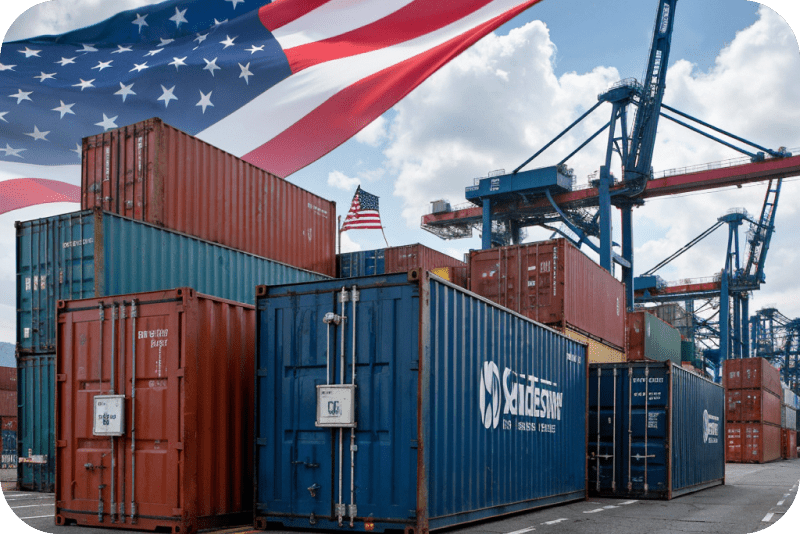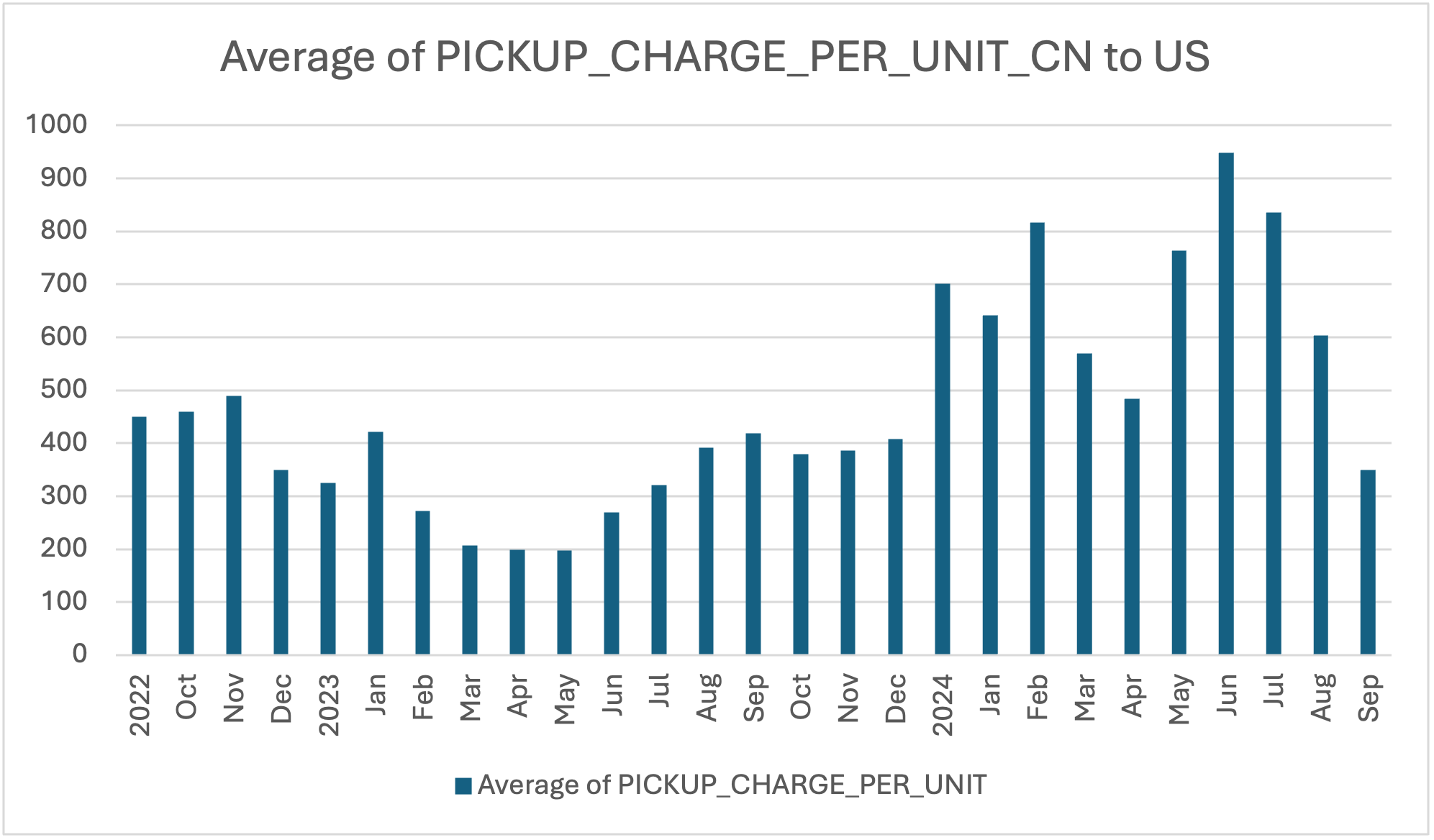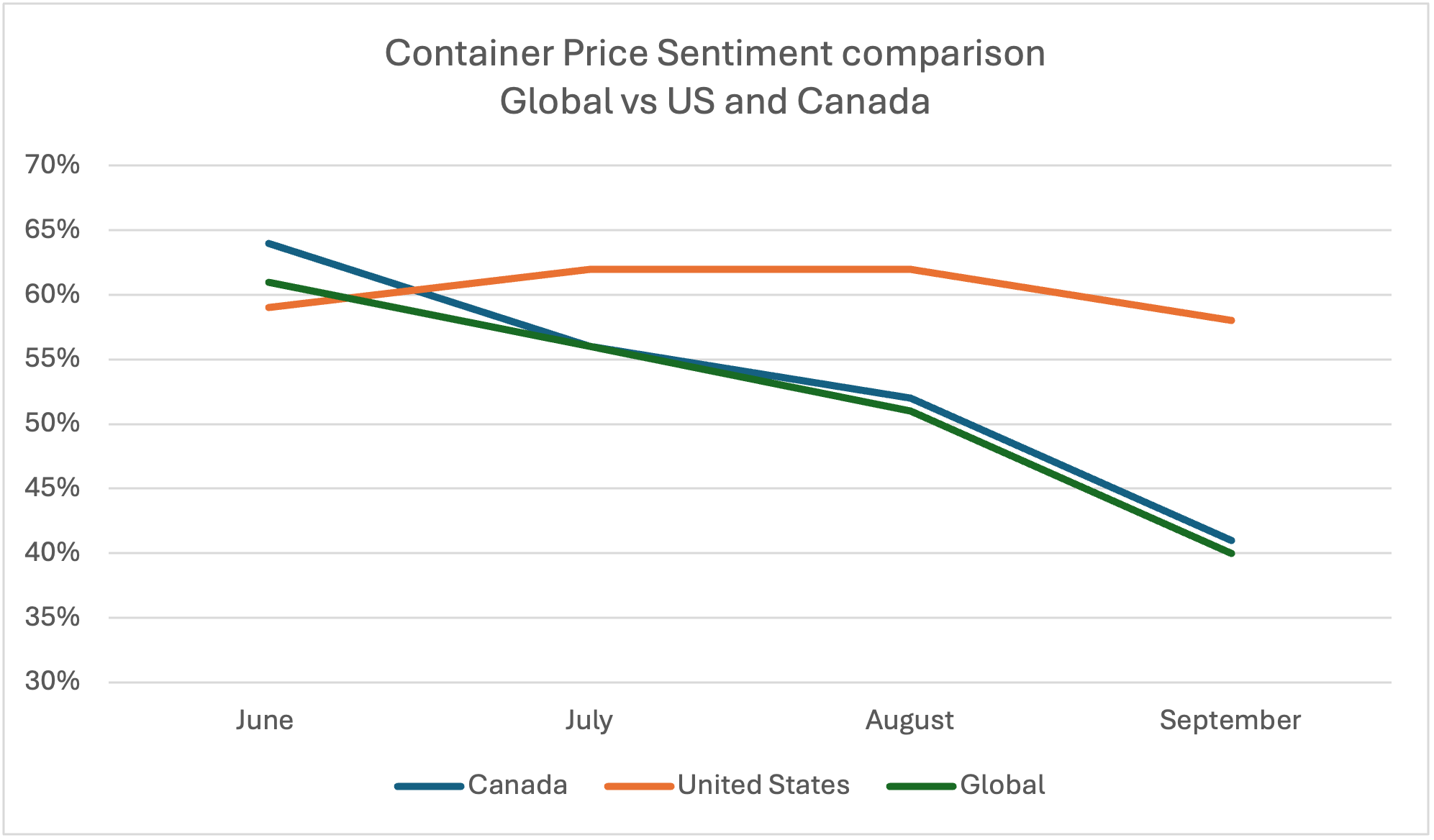08.11.2024

Container prices in the U.S. are rising, signaling a shift in the market backed by uncertainty on the implications of Trump’s re-election on trade tariffs and regulatory environment changes while China’s container prices continue to decline.
Traders should act now to leverage favorable conditions for profit, with an eye toward upcoming market shifts in 2025.
The U.S. container trading market is shifting, with rising import volumes and changing trade patterns influenced by geopolitical tensions. Ports like Long Beach and Los Angeles are experiencing near-record imports as businesses pull forward orders, anticipating tariff and regulatory changes from the U.S. elections and potential labor issues in early 2025. This increased volatility presents an opportunity for container traders to re-evaluate strategies and adapt to these evolving conditions in the best interests of their business.
There are multiple strategies that container traders can use to maximize profits in a volatile market, and one effective approach is the buy-repo-sell model. This model provides a structured way to capitalize on price differences between markets by purchasing containers at lower prices, repositioning them and earning pickup charges, and selling them in high-demand locations.
This analysis breaks down the key components of the buy-repo-sell model, such as purchase prices, pickup charges, and resale prices, and explores how sentiment index data (Container xChange’s proprietary market sentiment index)—both global and U.S.-specific—can guide smarter trading decisions.
We’ll also provide recommendations for optimizing strategies considering current market conditions.
With significant uncertainties expected in global trade next year, now is the time to refine your trading strategy, seize emerging market opportunities, and proactively manage potential risks.
A. What is the Buy-Repo-Sell Model?
Understanding the Buy-Repo-Sell Model: Key Components to Profitability
The Buy-Repo-Sell model enables traders to purchase containers in one location, move them to a high-demand market using a one-way lease agreement, and then sell them in the new market. Experienced traders can profit from this approach as they can capitalize on demand shifts and leasing credits along the way.
This clearly involves three steps –
- Purchase Price: The key to profitability lies in purchasing containers at a favorable price (e.g., taking advantage of current price dips in China).
- Container pickup charge: The container owner then “repositions” the container by leasing it out against a fee. While pickup charges peaked in mid-2024 and subsequently declined, they are now stabilizing, offering more predictability for traders.
- Resale Price: Profit is then locked in by reselling in high-demand locations such as key U.S. locations where prices are currently rising.
The trade becomes profitable when:
- The difference between the purchase price and the sum of the resale price + leasing fees results in a positive margin.
Profit Margin = (Resale Price + leasing fees earned) − Purchase Price
Timing is Key: Profitability in the buy-repo-sell model depends on strategically timing purchases and sales, as container prices, pickup charges, and market sentiment can fluctuate throughout the year. Close monitoring of these factors—including our Container Price Sentiment Index—can help traders make informed decisions and optimize their profit margins.
B. Current Market Overview: The Divergence Between U.S. and China Markets
- China Market
After peaking in June 2024, prices for 40HC containers in China have been on a steady decline. Traders looking to purchase should capitalize on this dip.
 Figure 1: Average prices for 40 ft High cube cargo-worthy containers in China
Figure 1: Average prices for 40 ft High cube cargo-worthy containers in China
- U.S. Market Upturn
In contrast, container prices in the U.S. have been rising since September 2024, buoyed by increasing demand driven by geopolitical factors and a strong domestic economy. Furthermore, our U.S. Container Price Sentiment Index (xCPSI) reflects growing optimism and market uncertainty, indicating continued price increases into 2025.
 Figure 2: Average prices for 40 ft High cube cargo-worthy containers in United States
Figure 2: Average prices for 40 ft High cube cargo-worthy containers in United States
 Figure 3 Comparison of average prices for 40 ft high cube cargo worthy containers between China and United States
Figure 3 Comparison of average prices for 40 ft high cube cargo worthy containers between China and United States
Pickup charges turning around:
Pickup charges (paid to the container owner at the start of a one-way leasing deal), which peaked in June 2024, have been gradually declining and have therewith reduced the profit of the buy-repo-sell model. Market indicators show that this decreasing trend is now stabilizing.
 Figure 4: Average Pickup charges from China to U.S. for 40 ft high cube cargo worthy containers
Figure 4: Average Pickup charges from China to U.S. for 40 ft high cube cargo worthy containers
Summary of current market condition:
The over proportional drop in pickup charges in recent months have led to the model becoming temporarily unprofitable in August. Since then, pickup charges are stabilizing and now offer profits once again. This means that if you were to buy units now, immediately resell them at current prices as a gate-buy deal and then move the units to the US, you would earn a small profit.
Profit margin for container owner = Selling price in U.S. + Pickup charge from China to US – cost of container in China
 Figure 5: Profit margin trend for repositioning Containers from China to US (buy in China, reposition in U.S., and sell in U.S.)
Figure 5: Profit margin trend for repositioning Containers from China to US (buy in China, reposition in U.S., and sell in U.S.)
However, these strategies become increasingly interesting when coupled with price expectations over the next 2-3 months (average time it takes for units to arrive in the destination on transpacific trades).
Think: Buy the unit now, move it to the US, then sell at the then-prevailing market price in 2-3 months. This strategy is clearly more speculative and risky, but can offer interesting margins. For this model to work out, traders must have a clear view on price expectations, ideally backed by data. Our xCPSI can offer such indications for traders to make more informed decisions.
C. U.S. Container Price Sentiment Signals Continued Growth Amid Global Uncertainty
Background:
Container Price Sentiment Index by Container xChange is a tool designed to capture and track the sentiment of market participants (such as traders, leasing companies, and container owners) about container price development in the coming weeks. It aims to provide insights into the direction of container prices over time, offering a real-time reflection of the market’s mood regarding pricing trends. The index ranges from –100% (i.e., everybody expects a decline of prices) to +100% (i.e., everybody expects an increase in prices). A value of 0% means that there is complete balance of positive and negative expectations.
This index can help traders and companies make informed decisions about container purchasing, leasing, and pricing strategies based on prevailing market sentiment.
Currently, the US xCPSI reflects strong optimism among U.S. based traders, signaling expectations of continued price increases in the near term—consistent with the current rise in container prices.
In contrast, the global xCPSI shows more caution and is decreasing, as traders outside the U.S. face plateauing prices in China and declining repo credits, tempering their outlook.
 Figure 6: Container price sentiment index (xCPSI) comparison of US, Canada and global readings
Figure 6: Container price sentiment index (xCPSI) comparison of US, Canada and global readings
D. Strategic Recommendations for U.S. Traders
- Leverage Market Sentiment: The rising U.S. Container Price Sentiment Index suggests price increases are likely. Traders should monitor market trends and capitalize on this upward momentum before prices rise further.
- Optimize Repo Costs: With pickup charges now stabilizing, traders should factor these revenues into their strategy, as it provides a clearer picture of profitability.
- Timing is Key: Traders should buy when prices are decreasing in China (currently the case) and sell during peak demand in the U.S. (expected to increase into 2025).
E. 2025 Outlook: Plan for Volatility and Opportunity
- Peak Seasonality: Expect increased container demand in high seasonality months. Traders should plan accordingly, either securing purchases in advance or holding inventory for future price appreciation. This is particularly true in the run-up to Chinese New Year 2025 which coincides with the inauguration of Trump and potential tariff introductsions.
- Geopolitical Uncertainty: Geopolitical factors like the U.S. elections and tensions in the Middle East will continue to affect global shipping demand, influencing U.S. container prices.
- China’s Price Stability: If China’s prices stabilize, traders can expect more favorable buying conditions. However, shifts in demand could also create new challenges.
- Call to Action: Fine-Tune Your Strategy for 2025
- Secure Purchases Before Prices Rise: Now is the time to purchase containers at favorable rates before U.S. demand pushes prices higher.
- Monitor trends in pickup charges: Leverage pickup charges to lower repositioning costs, maximizing profitability.
- Stay Ahead with Sentiment Data: Use tools like the Container Price Sentiment Index (xCPSI) to stay informed and anticipate market shifts.

